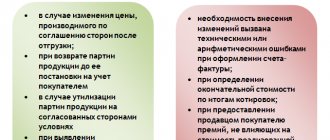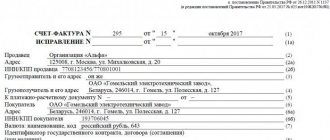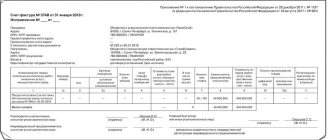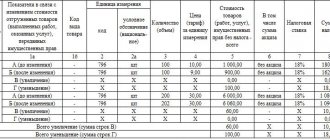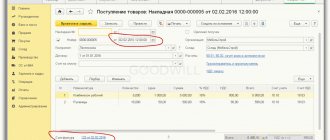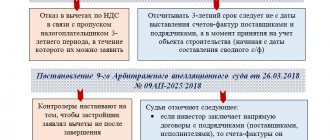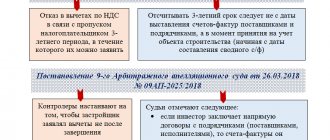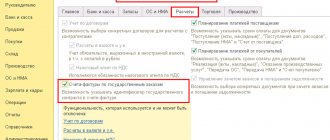How happy all accountants would be, and how easy it would be to work if no unusual situations occurred in the course of the organization’s activities. But, unfortunately, we do not live in an ideal world, and in our work we have to deal with various events every day. It is not always possible to sell a product and forget about this operation. Sometimes it happens that for one reason or another you have to make a return. Let's consider how this is reflected in the primary documents of the seller and buyer.
When the law allows the buyer to return the goods
By concluding a purchase and sale agreement, the seller and buyer expect that the conditions specified in it will be met - the supplier will ship goods of proper quality on time and in the agreed volume, and the buyer will pay on time and in full.
For various reasons, the buyer may refuse delivery and return the goods to the seller. The list of legal grounds for such actions is presented in the figure:
Civil legislation also provides that the buyer does not have the right to refuse delivery or return the goods if the seller promptly replaces the defective goods or completes them.
Simplified mechanism for processing return transactions
Since 2021, the technology for processing the return of goods in tax accounting has been significantly simplified.
See what suppliers and buyers need to take into account when processing product returns in 2021:
The phrase “we fill out an invoice for the return to the supplier” has now acquired a different meaning and the question of how to issue an invoice when returning goods is easier to solve than it was before 2019.
Full refund
Here is the procedure for issuing an invoice for a full refund. For example, a company purchased spare parts and capitalized them. But during quality control, multiple cases of defects were discovered, so it was decided to return the entire batch.
In this case, the procedure will be as follows:
- The buyer issued an invoice for the return of the goods to the supplier in full and, on its basis, charged VAT on the proceeds from the reverse sale (according to paragraph 1 of Article 146 of the Tax Code).
- The buyer registered this invoice in the sales book, and the previously received invoice from the supplier in the purchase book . As a result, VAT should be included in the total amount of deductions.
- The former seller must record the original invoice in the sales ledger and the one received from the buyer in the purchases ledger.
A sample invoice for reverse sales for the return of goods can be downloaded here.
The invoice issued by the buyer will be exactly the same as that previously received from the seller. The only difference will be that the seller and buyer on the invoice will need to be swapped.
It is worth noting that although this approach to issuing an invoice corresponds to the position of the Ministry of Finance, judges do not have a clear point of view on this matter. For example, one of the decisions of the arbitration court states that the return of low-quality goods is not a reverse sale, so the buyer does not need to issue an invoice.
If the buyer has not yet received the low-quality goods, then this does not bear any tax consequences for him, i.e. he does not have to issue an invoice to his supplier. He should simply issue a delivery note from Fr. Also, during the return of low-quality goods, documents such as a return certificate, an agreement to terminate the contract, a claim, etc. are drawn up.
For a supplier who previously included shipped goods in the sales ledger, it is necessary to create an adjusted invoice and register it in the purchases ledger. The adjustment invoice is issued by the seller taking into account clause 5.2 of Art. 169 of the Tax Code. The features of filling it out are as follows:
- Line “A” (called “before change”) indicates the data from the original invoice.
- In line “B” (“after change”) in column 3 with quantity or volume the value “0” is entered. Thus, the cost of the delivered goods and the amount of VAT are also reset to zero.
- In line “B” (“increase”), dashes are added, since the cost does not increase.
- Line D (“decrease”) shows data for line “A”.
A sample of an adjustment invoice, which is filled out when returning a supplier, can be viewed here.
The primary document is attached to this invoice.
When a return invoice is issued by the buyer
The current mechanism for processing the return of goods does not provide for the buyer's obligation to issue an invoice for the return. However, in some cases the buyer will still have to do this.
From the explanations of officials it follows that buyback is possible not only for unsold quality goods (when the buyer was unable to sell the goods by a certain date and returns them under the terms of the contract), but also for defective ones (letter from the Ministry of Finance dated May 15, 2019 No. 03-07-09 /34582, No. 03-07-09/34591).
Thus, issuing a return invoice from the buyer in 2021 is possible only in the listed cases and depends on the terms of the contract.
Reflection of the return in the buyer's accounting
Here again, everything depends on whether the goods were accepted for accounting.
If the goods are not registered, then no postings are required or made.
Otherwise, the following entries must be reversed.
| Operation | Contents of operation |
| D41 K60 | Reversal of the cost of the returned item |
| D19 K60 | Reversal of VAT that was received with the purchase of goods |
| D68/VAT calculations K19 | VAT, previously accepted for deduction, has been restored |
How to issue an adjustment invoice for a return
No matter how the seller and buyer call this document - “adjustment invoice for the return of goods to the supplier”, “adjustment invoice for the return of goods” or “adjustment invoice for return”, the technology for its preparation does not change. It is spelled out in Decree of the Government of the Russian Federation dated December 26, 2011 No. 1137.
We will show you with an example how to issue a correction invoice when returning goods.
(supplier) in December shipped to the buyer - JSC Typhoon - a consignment of goods worth 354,000 rubles, including VAT 59,000 rubles.
After the goods were accepted by the buyer for registration, and input VAT was declared for deduction, defects were discovered in some goods. The cost of low-quality goods amounted to 35,400 rubles, including VAT of 5,900 rubles.
JSC Typhoon drew up a report on low-quality goods and returned them to the supplier. Tornado LLC issued an adjustment invoice.
Digital data for filling out an adjustment invoice:
Before adjustment:
- quantity of goods - 500 pcs.;
- cost of goods without VAT - 295,000 rubles. (500 pcs. × 590 rub./pc.);
- VAT (20%) - RUB 59,000. (RUB 295,000 × 20%);
- cost of goods with tax - 354,000 rubles. (RUB 295,000 + RUB 59,000).
After adjustment:
- quantity of goods - 450 pcs.;
- cost of goods without VAT - 265,500 rubles. (450 pcs. × 590 rub./pc.);
- VAT (20%) - RUB 53,100. (RUB 265,500 × 20%);
- cost of goods with tax - 318,600 rubles. (RUB 265,500 + RUB 53,100).
Total reduction:
- cost of goods without tax - 29,500 rubles. (295,000 – 265,500);
- VAT (20%) - RUB 5,900. (59,000 – 53,100);
- cost of goods with tax - 35,400 rubles. (354,000 – 318,600).
Accounting for the return of goods from the supplier
When returning goods, in most cases the seller has to prepare a corrective invoice. At the same time, at the moment when the goods are actually accepted back, an entry is made in the purchase book. Accordingly, VAT on such a document can be deducted, and there will be no need to correct the declaration for the previous period.
It must be remembered that if only part of the goods is returned, the seller issues an adjustment invoice - an invoice, which is registered in the purchase book and corrects the amount of VAT payable to the budget.
It should also be noted that in connection with the change in the tax rate from 2021, the tax service indicated that when drawing up a corrective invoice, the rate that appeared in the original document is indicated.
Regarding income tax. In the case when the goods were purchased and returned in different periods, at the time of return of funds to the buyer’s account, non-operating expenses are accepted.
Tax nuances of returning goods
An adjustment invoice when returning goods is the basis document for the seller to receive a deduction. You can't do without it. In this case, the buyer and seller do not need to submit updated VAT returns for the period of shipment of goods in connection with the return.
Where the seller and buyer reflect the adjustment invoice for the return and why this needs to be done is shown in the diagram:
If the buyer discovers a defect upon acceptance of the goods and reflects it on an off-balance sheet account, he does not need to adjust his VAT obligations.
The procedure for the buyer and seller when returning goods is explained in letters of the Ministry of Finance dated 08/02/2019 No. 03-07-09/58362, dated 07/08/2019 No. 03-07-11/50174, dated 04/10/2019 No. 03-07-09/25208 and Federal Tax Service dated May 29, 2019 No. SD-4-3/ [email protected]
If you ignore this procedure for processing the return of goods and proceed according to the previous scheme (when the return procedure was accompanied by an invoice from the buyer), the seller will lose the VAT deduction.
Find out what tax consequences may arise in different situations:
- “Celebrating the New Year: tax consequences of a festive corporate party”;
- “Interest-free loan from the founder - tax consequences”;
- “Sale of real estate below cadastral value - tax consequences”;
- “Visa paid, but business trip cancelled: tax consequences”.
Part 2. Invoice: actions and operations when returning goods by the buyer
1. Return of part of the goods not accepted for accounting
If the buyer returns goods that are not accepted for registration, the seller issues an adjustment invoice for the reduction in value. It should be borne in mind that adjustment invoices are applied only if the buyer returns to the seller part of the goods not accepted by him for accounting. If the buyer refuses to accept the entire shipment, then the seller, in order to claim a tax deduction, registers in the purchase book his own invoice issued upon shipment of the goods. (see letter of the Federal Tax Service of Russia dated April 11, 2012 No. ED-4-3 / [email protected] ).
If, upon acceptance of the goods, the buyer discovers a defect, a mismatch, or for some reason (specified in the contract) decides to return the goods to the supplier, then, again, as in paragraph 3, this product must be accepted for safekeeping.
Further, all actions of the buyer and supplier are similar to actions in the event of a short supply of goods detected before the goods were accepted for accounting (clause 1 of Section I)
In addition, when returning, the buyer draws up a “Return of goods to supplier” document.
2. Return of the entire batch of goods not accepted for accounting
If the buyer refuses to accept the entire shipment, then the seller, in order to claim a tax deduction, registers in the purchase book his own invoice issued upon shipment of the goods. (see letter of the Federal Tax Service of Russia dated April 11, 2012 No. ED-4-3 / [email protected] ). To do this, the seller in the program:
a) Enters the document “Return of goods from the buyer.” On the VAT tab, the flag “The buyer issues an invoice for the return” is not set; the return must be reflected in the purchase book.
In this case, the buyer accepts the goods for safekeeping, then when shipping these goods back to the supplier, enters “Return of goods to supplier”. There is no need to fill out any documents related to VAT in the program.
3. Return of goods accepted for registration.
The return of goods accepted for registration by the buyer is processed as a return sale. Those. the buyer, now acting as a seller, calculates the amount of VAT on the returned goods, issues an invoice for the sale and registers it in the sales book. And the former seller, upon receipt of the invoice, has the right to deduct the amount of VAT on the returned goods, reflecting it in the purchase book.
Accounting with the seller:
a) A document “Return of goods from the buyer” is generated, in which the flag “The buyer issues an invoice for the return” is placed on the “VAT” tab and the invoice is entered using the link, which indicates the entry number and date of the invoice received from a former buyer.
b) In this case, when automatically filling out the document “Creating purchase book entries” in the program on the “Deduction of VAT on purchased values” tab, a line will be generated for the returned goods, where the former buyer will be presented as the supplier:
c) Based on the data in this document, a printed form of the purchase book will be generated, with a registered line of the invoice for return from the buyer.
Buyer's account:
a) a document “Return of goods to the supplier” is generated, in which the “VAT invoice is issued to the supplier” flag is placed on the “VAT” tab and the invoice is entered using the link.
b) This invoice must be reflected in the sales ledger. To do this, enter the document “Creating sales book entries”, in which, when automatically filled in on the “On sales” tab, a line will be generated for charging VAT on the returned goods, where the former seller will be presented as the buyer:
Because the return in this case is similar to a regular sales transaction, then there is no need to adjust tax liabilities and deductions for the period of sale of goods.
How to reflect the return of goods in accounting
If an adjustment invoice for a return appears in the accounting department, entries are made in the accounting accounts of both the buyer and the seller. Only the basis for them will not be an invoice (it is not a primary document), but other documents - for example, an invoice marked “Return of goods” (Clause 1, Article 9 of the Law “On Accounting dated December 6, 2011 No. 402-FZ ).
If the return of goods is formalized as a reverse purchase and sale and the return procedure is accompanied by the issuance of a regular invoice and sales invoice, the postings will be different:
Learn more about postings in a situation where the cost of the initial shipment changes in the article “How to reflect an adjustment invoice for a reduction .
What other documents are needed to return goods?
It should be borne in mind that the list of documents that need to be completed when returning goods has not undergone any changes. In order to return the goods, it is not enough to simply draw up an adjustment invoice.
Most often, a product is returned if it is of inadequate quality or a mismatch is detected. In this case, a document such as a statement of discrepancies is drawn up. If it is drawn up in the presence of the supplier, then his signature is placed on the document.
A claim is also drawn up, which contains a convincing request to accept the goods back, indicating the reason for the return and the quantity of the goods. Another document that is drawn up when returning is a return invoice. It should also indicate which product and in what quantity can be returned.
The report, along with the claim and return invoice, is sent to the supplier. The supplier, in turn, must accept the returned goods and at the same time make a note on the return label. The usual TORG-12 can be used as a return invoice, on which a note is made that such an invoice is a return one.
As you can see, returning an item is not that difficult. From 2021, a new procedure for processing the return of goods will be applied. This procedure applies to returns made after April 1. The burden of creating an adjustment set - invoice - lies entirely with the seller of the goods, who accepts the return. When making a return, you should be very careful about the formation of primary documents so that the regulatory authorities do not have any complaints.
Results
In 2021, when processing a return, the seller is required to issue an adjustment invoice, which will reflect the decrease in the cost of goods and VAT due to the return. The seller draws up the initial return document.
If the seller and buyer enter into a buy-back agreement for the returned goods or the original agreement contains a buy-back clause, the buyer acquires the status of a seller under the new agreement and issues a regular sales invoice.
Sources:
- Tax Code of the Russian Federation
- Decree of the Government of the Russian Federation of December 26, 2011 No. 1137 (as amended on January 19, 2019) “On the forms and rules for filling out (maintaining) documents used in calculations of value added tax”
You can find more complete information on the topic in ConsultantPlus. Free trial access to the system for 2 days.
What is an invoice
An invoice refers to the primary accounting documents that certify the actual shipment of goods or the provision of certain services, as well as their cost. An invoice is issued by the seller (contractor or performer) to the buyer or customer of services after final acceptance of the goods or services.
An invoice is necessary for tax accounting for VAT and is issued only by those suppliers who apply the general taxation system and are VAT payers (if the company is on the simplified tax system, then it can also issue an invoice, but with zero VAT). One of the purposes of an invoice is to confirm that VAT has been paid so that it can be offset.
The invoice details are fixed by the Tax Code; it must contain:
- serial number and date of receipt of the invoice;
- name, address and tax identification number of the supplier and buyer , consignor and consignee;
- payment document number when receiving an advance;
- name of goods supplied, work or services performed and unit of measurement;
- quantity of goods supplied;
- unit price;
- cost of goods;
- excise tax amount;
- tax rate;
- the amount of tax presented to the buyer;
- the total cost of goods supplied and services performed;
- country of origin of the goods and declaration number (for imported goods).
